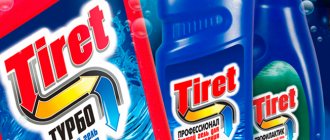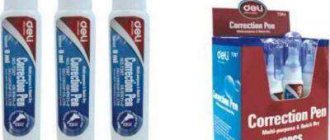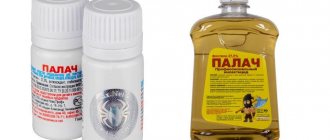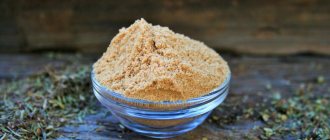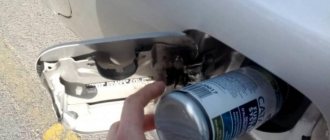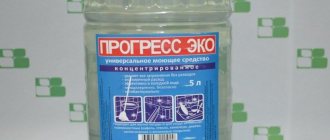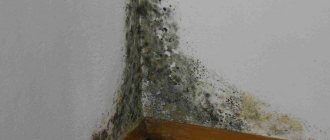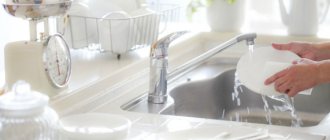Brake cleaner (English definition - brake cleaner) is intended for deep cleaning of metal surfaces from all kinds of contaminants, including process fluids, oil, tar deposits, dust and dirt. The product is used to degrease new brake discs before installation, remove old grease from guides in the brake system, and clean brake pads and other elements of the brake system.
We have compiled a rating of the 10 best brake cleaners, created exclusively on real tests conducted by car enthusiasts and professional craftsmen, as well as positive reviews of the product from specific companies that produce sprays that clean brake parts.
| Product name | Short description | Package volume, ml/mg | Price of one package as of summer 2022, Russian rubles |
| Liqui Moly Schnell-Reiniger | Fast acting cleaner. Can be used to clean components of braking and clutch systems. The test results showed very high effectiveness of the product. | 500 | 400 |
| G-Power | Universal cleaner for brake parts. It has a very powerful spray jet and short drying time. Low price, large volume and high efficiency. | 650 | 180 |
| Wurth | Universal brake system cleaner. Harmless to plastic, rubber, paintwork. During operation, you can turn the aerosol can over. Efficiency is good. | 500 | 300 |
| Berner | Universal brake cleaner. Can also be used for the clutch system. Cleans surfaces very well. Weak, but effective cleaning jet. | 500 | 300 |
| Forch | Brake and clutch cleaner. Has an easily transferable odor. Weak jet propagation. The package includes a spray tube. The effectiveness is average, sometimes you need to apply twice. | 500 | 250 |
| ABRO | Chlorine-free brake cleaner. Quite effectively dissolves contaminants. However, it contains acetone and other harmful substances, so it is very harmful to the human body and can damage rubber and plastic parts. | 397 | 450 |
| Hi Gear | Universal brake cleaner. Dangerous for rubber and plastic parts, as well as paintwork. With its help, you can process elements of the car's electrical system without voltage. Has an unpleasant smell. | 410 | 270 |
| Axiom | Cleaner for brakes and clutch parts. Does not contain acetone or chlorine-containing elements, so it has a tolerable odor. However, it is harmful to the body. Efficiency is average. | 800 ml; 650 ml. | 700; 550. |
| TRW | Average performance brake system cleaner. Often the product needs to be applied two or even three times for old stains. Affordable price is the main advantage. | 500 | 200 |
| Venwell | Cleaner for brakes and clutch system elements. It has low efficiency in dissolving oils and fats, but this is compensated by its low price. | 500 | 150 |
Why do you need to clean your brakes?
Nowadays, brake discs are made of various materials: from metal to ceramics. But no matter how high quality they are, friction does its job. During braking, the pads are pressed against the brake disc with force, which leads to friction with high contact loads. As a result, microchips and dust are formed. Most of them crumble onto the road, the rest settles on the surface of the discs and calipers and gets clogged into microgrooves and microcracks. Often we don’t even see this, mistakenly believing that the brakes are clean.
There is an opinion that sharp braking helps to clean the discs. But that's not true. Braking, including sudden braking, literally imprints microparticles of dust and chips into the disc, which leads to the appearance of microgrooves.
All this reduces the effectiveness of the brakes and also accelerates the wear of brake discs and pads. The use of low quality pads contributes to this.
Another reason to clean your brakes is corrosion. Due to prolonged lack of use or the car being left in a garage for the winter, or in a humid climate, the discs may become covered with a thin layer of rust. Because of this, the first few braking performances will be ineffective and corrosive dust will be embedded into the surface of the disc.
Causes of rust stains
During active use of the car, rust does not appear on the discs, since they are constantly polished while driving.
However, even a short downtime of a few days leads to the formation of corrosion on the metal. This process is especially intense in conditions of high air humidity.
So, the main reason for the formation of rust on brake discs is prolonged idle time of the vehicle. These elements are not protected by anything, therefore, like any other metal parts, they oxidize.
Electrochemical method
This is an anodic cleaning method that is capable of combating powerful rusty layers. It is used in industry, but with its help you can remove rust on machine parts with your own hands. It may not work the first time, since you will have to select the concentration of the solution and the current strength.
Necessary equipment and chemicals:
- DC source 12 - 36 V and up to 1 A. You can take a power supply from a computer or a car battery.
- Soda Ash. The approximate concentration for dilution is a teaspoon per liter of water.
- A plastic container that will hold the part to be cleaned.
- A piece of stainless steel. You can get cat dishes from a pet store.
- Connecting wires, clamps. It is advisable to include a current regulator in the circuit so as not to overload the power source.
Further actions:
- Dissolve soda ash in the required amount of water. For better dissolution, heat the water.
- Place the part to be cleaned in a container, connecting it using a clamp and wire to the “+” terminal of the power source.
- Place a stainless steel object connected to the “–” terminal of the source in the same container. The parts in the container should not touch each other.
- Pour the soda solution into the container so that it completely covers the damaged part.
- Turn on the power source and make sure that the process begins: foam will appear, and air bubbles will escape from the rusted part.
- Make sure that the corrosion layer is separated from the surface and goes into the solution, which becomes dirty brown.
- Wait a few hours to ensure the part is completely cleaned. The time depends on the degree of corrosion of the part.
In terms of cleaning power and quality, this method is not inferior to sandblasting. But with it, oxides are removed without damaging surfaces.
When and how to clean your brakes
Cleanliness of automobile components is the key to their durability and safety on the road, especially when it comes to the braking system. It is necessary to clean the brakes:
And also, preferably, in spring and autumn, when preparing the car for the summer or winter season.
When servicing your car at an official dealer, you will be given such cleaning even without a reminder, and they will do it with professional and special means.
But in ordinary auto repair shops and during self-service, this stage is often skipped. Brakes are usually only cleaned if they are heavily and visibly dirty.
And how do they do it? Clean with a regular brush or any cleaner you can get your hands on. Which is fundamentally wrong. Any mechanical cleaning releases dust, which settles on the elements of the brake system. And the use of gasoline, organic or mineral solvents has an extremely negative effect on the seals and boots of the brake cylinders.
Therefore, you should not tempt fate and remember traditional methods, but simply use a special tool. There is a wide range of brake cleaning products available on the market today. You can purchase them at any automotive store or at most regular supermarkets.
Folk remedies for cleaning
Folk remedies work no worse than professional cleaners, but are much cheaper. You can deal with rust on wheels using the following compounds:
Lemon acid. It is diluted in warm water. For every 10 liters you will need 50 g of preservative. The disk is completely immersed in the solution and left for 24 hours.
After treatment, the product is washed with a soda solution and then with clean water (read more about removing rust using citric acid here).
Table vinegar. It is used like citric acid. For 10 liters of water you will need 250 ml of vinegar with a concentration of 9%. If the rust layer is thick, then the amount of vinegar is doubled (you can find out more here).
Orthophosphoric acid . It can be purchased at construction stores. The discs are treated with this composition, left for 15 minutes, after which they are washed off with a soda solution and clean water.
Soda slurry. It is convenient to treat small areas of corrosion. The product is prepared in such a way that its consistency resembles sour cream. The paste is applied to the rust, left for an hour, and then removed with a damp cloth.
Sparkling water. To combat metal oxides, you can use Coca-Cola, Sprite or Pepsi. To increase the effectiveness of the procedure, the drink is slightly heated (up to 40 degrees). The disk is completely immersed in Cola and left for a day, after which it is removed, rinsed with clean water and dried.
All of the above products are harmless to metal, so they can be used as often as necessary.
Helpful information
To ensure that the cleaning procedure is as effective and safe as possible, you must adhere to the following recommendations:
All work must be carried out outdoors or in a room with good ventilation.- Only plastic or glass containers can be used to soak parts. Metal basins are not suitable for this purpose.
- Blackening of the metal or the liquid in which it is soaked is a normal reaction. It indicates that the cleaning process is active.
- To speed up cleaning, you can heat the solution by lowering a boiler into it. In this case, inhalation of vapors should not be allowed.
- If it was not possible to get rid of rust the first time, repeat the procedure 1-2 more times. If necessary, you can increase the exposure time.
You can learn about methods and methods for removing rust from a car here.
What is brake cleaner used for and how does it work?
During braking, the pads are pressed against the disc with enormous force. In this case, friction occurs with large contact loads. The pad material is softer than the disc metal. Therefore, the pad gradually wears out with the formation of wear products. These wear products partially fall onto the road. But some part settles on the surface of the brake disc and gets clogged into microgrooves.
Modern brake pads are made from a variety of materials: from metal to ceramic. But regardless of the material of manufacture, wear debris that remains on the disc worsens the adhesion force. That is, the effectiveness of the brakes is reduced. The second negative effect is accelerated wear in this friction pair. Fine abrasive particles accelerate wear of both discs and pads.
In parallel, the braking performance is affected by the presence of corrosion. It often happens that after a car sits in a garage for the winter, the wheels become covered with a thin layer of rust. And the first few dozen braking sessions will take place with low efficiency. And subsequently, corrosive dust will fill the microrelief of the disc, which will also negatively affect the braking system.
Brake disc cleaners have two positive effects: they remove contaminants from working surfaces and remove corrosion. And this, in theory, significantly increases the braking force and service life of the pads and discs.
Special formulations
You can get rid of rust using converters or removers, which are sold in auto parts stores. They have different release forms, so when purchasing you need to pay attention to the following points:
- Spray. It is chosen when you need to treat a small area of corrosion. The spray is convenient to apply, since there is no contact between the skin and the active substance.
- Liquid form. Such compositions are an ideal solution for removing rust from the entire disk. The solvent is poured into a suitable container and the part is completely immersed in it.
- Rust converter. Such compositions not only help dissolve corrosion, they provide additional protection for the metal from its reoccurrence. This is why it is so important to purchase formulations with added zinc.
Regardless of the product you choose, before using it for the first time, you should carefully read the instructions.
Top 3 popular compositions for removing rust from brake discs:
Rust converter AUTOPROFIT Galvanized. The composition is available in the form of a solution, which is bottled in convenient bottles equipped with a sprayer.
The product removes rust and prevents its reappearance, creating a durable zinc coating on the surface. For 550 ml of the product you will need to pay 225 rubles.
Rust remover SYNTIROL. The product is available in liquid form. It has an immediate effect on corrosion, removing it in 4-8 minutes. The cost of 1 liter is 450 rubles.
Rust Remover spray. The composition is completely ready for use. It is applied directly to the corroded area. After just 10 minutes you can evaluate the result. One package is enough to process 5 m2. Prices are here.
EFELE CL‑546 Spray
EFELE CL-546 Spray is a Russian-made brake cleaner. It is made on the basis of safe special solvents, detergent additives and propellant gas.
The product effectively removes oily and tarry deposits, carbon deposits, and removes wear products from the brake system. It does not destroy elastomers and plastics, evaporates completely and without residue, and can be used to degrease surfaces before gluing, sealing or cold welding.
The cleaner has a fairly powerful jet that quickly removes various contaminants, including from hard-to-reach places.
The characteristics of the EFELE brake cleaner fully meet the above requirements, and its cost is one of the lowest among the materials presented in the rating.
WURTH
Cleaner based on gasoline solvent. Does not contain silicones and adsorbed organic chlorine.
The product is designed to quickly remove oils, grease, soot, dirt, soot, brake dust from linings, shoes, pads, mechanism housings, etc.
The material has a fairly strong spray jet, so dirt can be removed from surfaces without much difficulty.
Can also be used as a degreaser before gluing.
This cleaner also meets the requirements listed above and is low cost, but it does not deal with some contaminants as effectively as the EFELE cleaner.
Liqui Moly Bremsen- und Teilereiniger
Liqui Moly Bremsen- und Teilereiniger is a cleaner based on acetone-free solvents.
The product provides reliable and easy cleaning and degreasing of surfaces and has good penetrating ability. It removes tar and tar deposits, oil and grease stains.
The material has low surface tension and leaves no residue. It can be used to clean various car parts and also as an all-purpose cleaner.
The characteristics of Liqui Moly are similar to previous materials, but its cost is slightly higher.
Motul Brake Clean
Motul Brake Clean is a chlorine-free brake cleaner. Billed as a super-powerful degreaser.
The material is intended for cleaning elements of mechanical systems and electrical equipment, brake pads, discs, calipers, engine parts, clutches, shock absorbers, chain tensioners.
It quickly removes traces of oils, grease and tar, and evaporates without leaving a residue in a short period of time.
This cleaner is quite aggressive to varnishes, paints and plastics, and also does not have high cleaning properties and is characterized by a rather heavy odor.
Motul Brake Clean has average performance and a higher cost compared to previous cleaners.
VMPAauto
VMPAauto brake cleaner is another Russian-made product based on aliphatic hydrocarbons.
The material is intended for cleaning brake discs, drums, cylinders, calipers, pads, ABS components, clutch parts. Can be used to clean tools and various metal surfaces.
The product does not have a strong odor, evaporates quickly, and leaves no streaks or marks.
In terms of characteristics, this is a fairly standard cleaner, but it does not have sufficiently high cleaning properties. One of the advantages is the large packaging volume of 650 ml.
BOLL
A product with a strong cleansing effect and good penetrating properties. Suitable for disc and drum brakes and all engine oil components. Not harmful to rubber and plastic elements, does not cause corrosion. It even removes dried and stuck-on dirt. Shake the can for 3 minutes before use. Then apply the cleaning agent to the dirty element at a distance of about 20 cm and wait until the product dissolves. Leave to dry or wipe with a dry cloth. If the dirt is so large that the operation did not work, repeat it.
Capacity: from 400 ml. Price: 200 rubles
Cleaning products can also be used for many other tasks often performed in workshops. Prices on average 180 rubles per 500 ml are affordable, so it’s worth purchasing such a product.
Popular brake disc cleaners in Russia
Let's briefly look at several means for removing contaminants from brake discs, drums and car calipers.
- Liqui Moly Bremsen- und Teilereiniger. The most common remedy in Russia. Available in 500 ml bottles. The active ingredients are polyhydric solvents of petroleum origin, mainly heavy fractions, as well as active substances that neutralize corrosion. The product has a high penetrating effect. It eats well into difficult-to-soluble contaminants, such as resins, thickened lubricants, fats and other solid deposits (wear products of brake pads) and breaks them down.
- Lavr LN Inexpensive product for quick cleaning of discs and drums. Sold in 400 ml aerosol cans. Breaks down wear products of brake pads and degreases the working surface of discs and drums.
- 3ton. Available in 510 ml cylinders. Average cost product. Penetrates well into the grooves on discs and drums, dissolves hard, tarry and oily deposits and promotes their removal. Has a rust cleaning effect.
There are several other less common brake cleaners. Their composition and operating principle are practically no different from the above mentioned products.
Reviews from motorists and expert opinions
With regular use, all of the above products, as well as their other analogues, will help maintain the efficiency of the braking system at the proper level. That's what auto chemical manufacturers say. What do motorists and service station technicians say? Below we have selected some of the most frequently found reviews about brake cleaners on the Internet.
- After applying and wiping with a rag, the brake disc (or drum) visually becomes noticeably cleaner. The gray tint disappears. Rust spots on the work surface disappear or become noticeably smaller. A more pronounced shine of the metal appears. That is, the effect is visually noticeable immediately after application.
- Braking efficiency increases. This has been repeatedly tested and proven both in real conditions and on a test bench. The increase in braking force, depending on the condition of the system as a whole and the degree of contamination of the discs, is up to 20%. And this is a significant indicator, considering that apart from the use of inexpensive auto chemicals, no other work was carried out.
- With regular use, the service life of both discs and pads increases. Typically, the resource increase does not exceed 10-15%. Subjectively, motorists and service station technicians see the feasibility of using brake cleaner from an economic point of view, especially if the brake system is expensive.
The conclusion from all of the above can be drawn as follows: brake cleaners really work. And if you want to always use the brake system to the maximum, then a brake disc cleaner will help with this.
Caliper repair
Home > REPAIR and servicing > Brakes > Caliper repair
In this article I will talk about small nuances that will help the brake caliper resist our aggressive operating conditions longer. As we know, the caliper has only three moving parts, two guides, and the piston itself. All these moving parts are protected by rubber seals, and they eventually lose their elasticity, allowing moisture to creep into places where it shouldn't be. The work can be performed both in a garage, and in a car service center, or a small workshop.
So, we remove the brake caliper, by hook or by crook we pull the piston out of it. Usually there is enough air from a compressor with 8 atmospheres, and if everything is bad, then we put the caliper in place, start the engine, and press the brake until the piston falls out of the caliper.
To prevent brake fluid from dripping, they usually stick a stick between the brake pedal and the seat, or clamp the brake hose with a clamp. The second method is not the best, but the most convenient and fastest. Criticism will choke on saliva, screaming that this is a bad car service, that you can’t clamp the hose, that the internal reinforcement in it breaks, etc. But from personal experience, since 1998, not a single car has arrived with problems after such a clamp.
Next, we take a specially made drift or bolt with a diameter of 8 mm and push out the guide bushings.
We remove the sealing rubber bands and carefully examine the seats of the guide bushings. If there is rust and dirt there, then you need to get rid of it, you can use a thin screwdriver and sandpaper on a rag base, rolled into a thin cord, depending on the design. The inner walls of the caliper guides also need to be cleaned. And make sure that the bushings move easily in their seats without rubber cuffs. And for now we leave this part of the brake caliper alone.
After this, remove the working cylinder from the cuff. Let's see how bad everything is there. Remove the O-ring and get to work. Having inserted device No. 345F16 into a drill or screwdriver, we clean out the rust to the state of new and shiny metal. If you do not have device No. 345F16
, this job of cleaning the brake caliper can be done with sandpaper and a suitable screwdriver; the result is important to us, not the tool.
This place also needs to be cleaned, to such an extent that the piston easily, without jamming, falls into the caliper seat under its own weight.
When everything goes in and out easily, we wash the brake caliper from dirt, dust, rust, blow it with air, and begin assembly. We insert the O-ring and lubricate the ring itself and the cylinder walls, between the ring and the edge of the cylinder.
We take the piston boot, and lubricate its outer side, the one that fits into the caliper, and insert it into place. Secure with a locking ring. Some brake calipers do not have a retaining ring (Nissan).
We take a piston that has been cleaned of dirt and rust and lubricate it in two places. And we put it into the cylinder. It’s better to do this together, it’s faster and easier. But with some skill you can do it alone.
We check that the rubber is seated correctly in the groove of the piston, and push the piston inside the brake caliper.
Next, lubricate the seats of the caliper guides, and pick up the guide boot. Apply a little grease to the boot, in three places. Two places, one inside and one outside, and insert it into place.
Having finished installing the guide boots, we take the bushings themselves in our hands and apply lubricant to it.
We insert the guide into its place, and do the same with the second guide sleeve. And that’s it, the caliper repair work is finished. All that remains is to put the caliper in place and bleed the brake system.
If the car is old, then the pumping procedure can be found here: Brake fluid. If it’s fresh, then pump it from the farthest wheel. If you can't handle it, contact our car service center. We will be happy to help you. If you have any questions, you can ask them on our forum.
